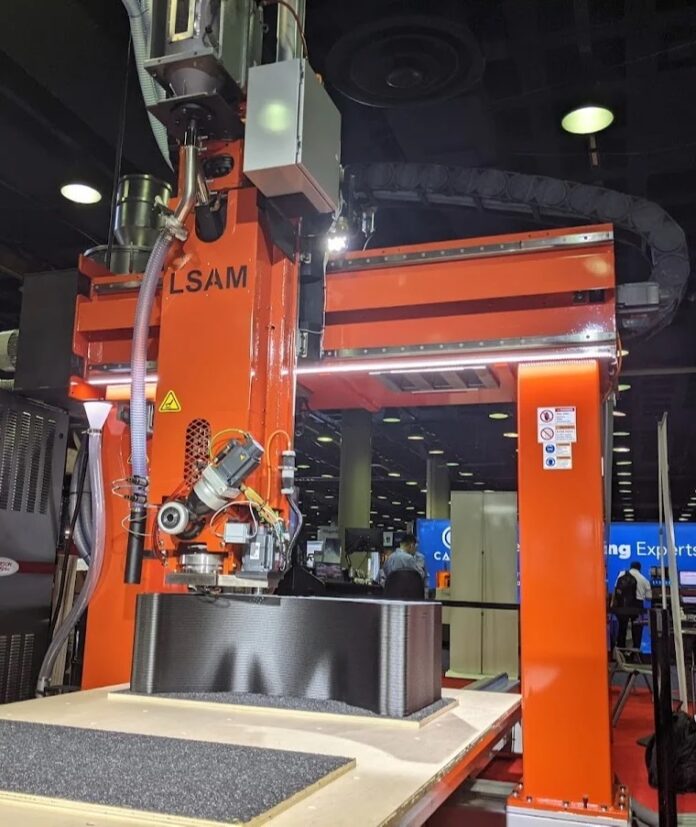This year’s Rapid + TCT conference in Chicago featured a range of machines and parts, from huge robotic AM machines to the nearly microscopic printed metal pieces used for hearing aids. However, one installation towered above the rest. Thermwood was there showing off their LSAM AP510 machine.
If you’re a regular reader of 3D ADEPT Media, you are certainly familiar with Thermwood. The machine manufacturer made Large-Scale Additive Manufacturing (LSAM) its core business as they wanted to provide an alternative to the widely spread polymer 3D printing approach. Their portfolio starts with the AP510 at a bed size of 5’ by 10’, and goes up to the LSAM 1540 that prints on an expansive 15’ by 40’ platform. For readers in the US, that’s about the length of a school bus. As explained in a recent article, this approach was hard to scale up, for large near-net-shape parts, hence the focus on the development of dedicated systems.
Our conversation with Thermwood’s Executive Vice President, Jason Susnajara gave us the opportunity to confirm how the company headquartered in Indiana, is walking the talk on a number of topics we have been discussing for the past several years.
For the record, Thermwood has been showcasing its LSAM expertise on various European and American trade shows. Among the wide range of shows where we’ve had the opportunity to meet the company’s representatives, Rapid+TCT gave us the chance to appreciate a live demo of the company’s technology. As English clergyman Thomas Fuller said: “Seeing is believing, but feeling is truth.”
While we were talking with Jason Susnajara, an orange behemoth worked away at printing a green plastic chair.
Hope for the future of recycling
According to Susnajara, the opportunities for large-scale 3D printing lie in the fact that manufacturers can save on labor and material costs. Thermwood was showing off the AP510’s sustainability side by 3D printing the chair with polymer pellets made from recycled plastic bottles.
Remember when we discussed the arguments that would play to the strengths of LSAM when it comes to sustainability? Recycled materials were the second argument mentioned in the “environmental category” to help organizations embrace a sustainability journey. We knew Thermwood’s LSAM machines could process recycled composite chopped fiber-reinforced polymer (FRP) pellet materials, thus improving material efficiency and reducing material waste. At Rapid+TCT, we got the chance to learn more about one of these materials.
The AP510 3D printer was processing an LNP™ ELCRIN™ WF0061BiQ material, developed by SABIC, a specialty chemicals company that is also active in the AM industry. The material comes from PET water bottles that SABIC transformed into polybutylene terephthalate (PBT) resin to create polymers with new properties compatible for AM. The newly-developed material delivers the same strength and quality as the virgin PBT resin.
We didn’t ask if these materials could be used to achieve industrial LSAM applications. We believe they can, given the strength of the chairs printed and the properties of the material processed. Nevertheless, we do hope to continue this conversation on other focal points that could help demonstrate how the triple bottom line is met at the manufacturing level.
During the live demonstration, a sort of camera was monitoring the printing process as it was taking place. With the camera, one could see how the temperature of a printed layer was measured just before a new bead is added which enabled the printer to automatically regulate the feed speed. According to Susnajara, the idea is to find the perfect balance between cold and heat in order to have the desired shape. With this layer time option, one can go slow enough so that the printing process would be at, or very close to, the perfect temperature needed to achieve the best possible layer-to-layer fusion. From what we saw, the machine was printing 200 pounds/hour (90Kg of pellet materials/hour).
The AP510 had an imposing presence on the exhibition floor at Rapid + TCT. Susnajara said they were printing four chairs throughout the three-day show. Onlookers would stop and tilt their heads upward to take in the whole machine. The chairs we saw at Rapid+TCT were strong, and so heavy (around 40 pounds ≈ 20kg) they look unbreakable. After the show, they would go back to Sabic’s plant.
Industrial applications enabled by Thermwood’s LSAM
As far as the market for these printers goes, Susnajara said Thermwood’s LSAM machines are being used for applications like autoclave molds. Such components usually require a rigid mold that defines the final shape of the composite part, in order to manufacture an end-use part that must deliver high-performance properties and withstand austere environments. As a reminder, Thermwood previously shared how it manufactured an autoclave tooling of 1150mm x 760mm using SABIC’s LNP™ THERMOCOMP™ AM EC004XXAR1 compound, a 20 percent carbon fiber-filled ULTEM™ resin material. The printing process of this tool required eight hours and they required 12 more hours for machining using the LSAM® printer.
Other industrial applications from Thermwood that are worth recalling – and that have been publicly shared, include Meander, a large sculpture that highlights Missouri River’s footprint in KANSAS, the massive 3D printed torch in the new Las Vegas stadium or a Yacht Hull Mold. These applications demonstrate that with a little imagination and some creative engineering, large structures can be made, even on the smallest of Thermwood’s additive manufacturing systems.
LSAM composite for tooling continues to be evaluated to ensure the industrial base can handle future manufacturing surge requirements. Given the milestones and applications it has already achieved ever since it debuted on the market, Thermwood remains one to watch in this industry.






